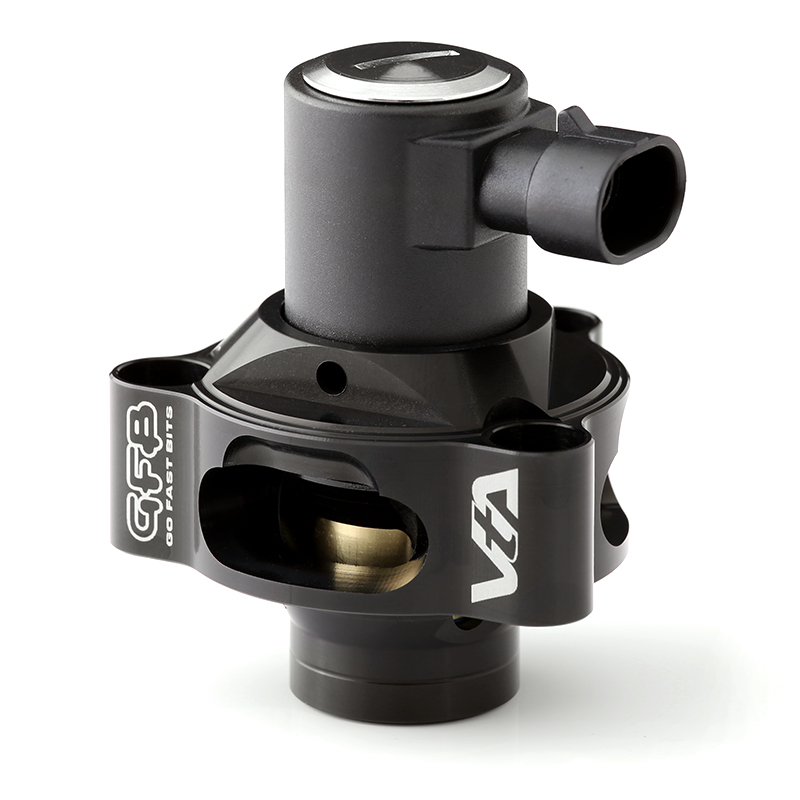Product Range Information
Features and Benefits
-
Capable of handling upwards of 50psi.
-
Direct-fit replacement with GFB’s TMS benefits.
-
Utilises pilot actuated operation, allowing for increased throttle response and better drivability.
-
Replaces weak plastic components with metal components which have been found to solve boost leaks and improve boost holding.
-
Flexible installation: choose between retaining the factory solenoid coil for a budget friendly upgrade or a quick drop-in replacement valve with a fully integrated solenoid.
-
Progressively opens in response to boost pressure – only opening as much as is required.
-
Vent to atmosphere capable.
Self-troubleshooting Steps
How do I know that my VTA is working as intended?
- Uninstall the VTA from your vehicle and lay the body of the VTA on its back and press against the piston. You should be able to freely press against the piston without getting stuck.
- If you do find that there is some abnormal behaviour, please do not hesitate to contact us via the link below. Please be sure to include a video of your performing this test.
I’m finding that I’m losing boost whilst on throttle! Help!
- If you’re experiencing this, we highly recommend double checking that you’ve used our GFB provided plunger spring and not the plunger spring that was included with your OEM solenoid. Using this spring would result in the VTA to prematurely vent whilst accelerating.
FAQ
What’s the difference between the VTA and DV+?
The main difference between the VTA and DV+ is only that the VTA is capable of venting to atmosphere whereas the DV+ cannot. They both have the same performance related benefits being better boost holding, solving boost leaks and increased throttle response.
Why does my piston have a blue seal instead of the silicon one that I’ve seen before?
We’ve recently adopted more modern production methods and sustainable materials that have allowed us to evolve our piston seal technology. By changing to a blue VITON seal, we’ve been able to ensure that we’re still able to guarantee the same performance and durability at our high-quality standards. Performance without compromise.
What is the actual size difference between a VTA without an integrated solenoid and one of your other VTA’s with the inbuilt solenoid?
Compared to our other VTA’s that reutilise the OEM diverter valve solenoid, the integrated solenoid VTA’s are significantly smaller. This means that you will be able to have both an aftermarket turbo inlet pipe and our VTA without encountering any fitment issues.
I think I’ve disassembled all the required parts of my OEM solenoid but still can’t install my VTA, what do I do?
Please ensure that these major components have been disassembled from your OEM diverter valve including: the basket (rev D) or diaphragm (rev G) and the piston shroud. In most cases, the piston shroud is still left on the diverter valve solenoid when attempting to install the body of the VTA onto the solenoid. We recommend using either pulling out by hand or using a flat head screwdriver to help lever this shroud out. If you’ve removed all these components, please be sure to use the following reference image to help ensure that all components have been removed.
If this still persist, please contact us via the link below.
Do any components in this kit need to be lubricated with engine oil?
No! Unlike our DV+ kit, you will not need to lubricate the piston or plunger of your VTA. We pre lubricate the piston when installing the piston into the body of the VTA and there is enough blow by through your engine to help keep this piston lubricated. You will also, not need to lubricate the plunger.
Am I able to install a whistling trumpet on my VTA?
Unfortunately, no. The 5701/5702 whistling trumpets are designed specifically for our Mach 2, Hybrid, Respons and Deceptor Pro II valves and are not compatible with the T9430 VTA. They are differently sized trumpets and are not interchangeable.
What does the spring preload screw do for my VTA? Is it necessary to do?
Adjusting the spring preload screw is an optional step that can be performing in an attempt to improve throttle response and reduce lag. The pressure balancing design of the VTA means that until the ECU decides to open the diverter, there is equal boost pressure on both sides of the piston, so it will stay shut under boost regardless of the spring setting or the boost pressure.
